Carbon sequestration in biomass and soil following reforestation:a case study of the Yangtze River Basin
Jianyu Wang·Claudio O.Delang·Guolong Hou·Lei Gao·Xiankun Yang·Xixi Lu,
AbstractThe effect of reforestation on carbon sequestration has been extensively studied but there is less understanding of the changes that stand age and vegetation types have on changes in biomass carbon and soil organic carbon(SOC) after reforestation.In this study,150 reforested plots were sampled across six provinces and one municipality in the Yangtze River Basin (YRB) during 2017 and 2018 to estimate carbon storage in biomass and soil.The results illustrate that site-averaged SOC was greater than site-averaged biomass carbon.There was more carbon sequestered in the biomass than in the soil.Biomass carbon accumulated rapidly in the initial 20 years after planting.In contrast,SOC sequestration increased rapidly after 20 years.In addition,evergreen species had higher carbon density in both biomass and soil than deciduous species and economic species(fruit trees).Carbon sequestration in evergreen and deciduous species is greater than in economic species.Our findings provide new evidence on the divergent responses of biomass and soil to carbon sequestration after reforestation with respect to stand ages and vegetation types.This study provides relevant information for ecosystem management as well as for carbon sequestration and global climate change policies.
KeywordsBiomass carbon·Soil organic carbon·Stand age·Vegetation type·Yangtze River Basin (YRB)
Introduction
The amount of carbon dioxide (CO2) absorbed and carbon accumulated after reforestation largely depends on forest primary production (Churkina and Running 1998).Atmospheric carbon is stored in wood,leaves and soil (Justine et al.2015).Therefore,newly planted and naturally regenerated forests increase the storage of biomass carbon and soil carbon (Canadell and Raupach 2008).In carbon cycle studies,biomass carbon is an important indicator of vegetation growth and amount (Houghton et al.2009).Trees,shrubs and herbs in forests provide primary carbon sequestration(Thomas and Martin 2012).Soil organic carbon (SOC)dynamics also play an important role in carbon cycles because small changes in SOC stock significantly influences atmospheric CO2concentrations (Stockmann et al.2013).CO2is removed from the atmosphere and stored in the soil,thereby improving soil properties and decreasing soil erosion (Kimble et al.2007).
Carbon sequestered in biomass and soil varies by age of stands,plant types and environmental conditions (Laganiere et al.2010;Zhao et al.2014;Xu et al.2018).Stand age influences the rate of carbon sequestration (Guo and Ren 2014),while the relationship between age and carbon stocks in biomass and soil is not necessarily linear.
Atmospheric CO2concentrations have increased rapidly as a result of urbanization,industrial manufacturing,and fossil fuel consumption,especially over the past two decades (Schimel et al.2015;Ali and Yan 2017;Baldocchi and Penuelas 2019).Reforestation of degraded croplands and barren lands has been proposed as an effective means for sequestering and accumulating carbon (Houghton and Hackler 1999;Foley et al.2005).Over the last four decades,China has implemented several national forest conservation and restoration projects which have significantly increased the carbon pools of forest ecosystems (Tang et al.2018).Between the 1970s and the 2000s in China,biomass carbon stock increased by 40%,with soils storing more carbon than plant biomass (Sundquist 1993;Lu et al.2018).
Forest conservation and reforestation projects have included the Natural Forest Protection Program (since 1999),the ‘‘Grain for Green’’ (GfG) program (since 1999) and the Three-North Shelterbelt Forest Program (since 1978) (Delang and Yuan 2016;Fang et al.2018).Due to its steep lands,serious soil erosion problems,and high sediment yields,the Yangtze River Basin (YRB) has been the main area for the implementation of the ‘‘Grain for Green’’ (Delang 2019).With the GfG,people plant both ‘ecological species’ (from which income can only be obtained from pruning and logging) and ‘economic species’ (species from which income can be obtained from the sale of fruits),while rules stipulate that at least 80% of the species have to be ecological.A better comprehension of carbon sequestration in economic trees versus ecological trees in reforested lands improves evaluation of the reforestation programs.
Carbon dynamics after reforestation in the YRB is poorly understood.Previous studies focused on estimating SOC or biomass carbon pools separately (Wang et al.2013;Kong et al.2020).Because of the scarcity of soil or biomass carbon measurements,carbon storage and sequestration were typically estimated using a fixed ratio between biomass and soil carbon (Shvidenko and Nilsson 2003;Pan et al.2011).Some studies suggest that carbon biomass/SOC ratios may lead to large uncertainties in carbon storage estimations because carbon in biomass and soil can differ considerably across ecosystems and climates (Piao et al.2009;Hong et al.2020).For example,in tropical forests 56% of carbon is stored in the biomass and 32% in the soil,while in boreal forests only 20% of carbon is in the biomass and 60% in the soil (Pan et al.2011).In Chinese terrestrial ecosystems during the 1980s and 1990s,58% of carbon sequestration occurred in the biomass and the remainder in soil organic matter (Piao et al.2009).In addition,from 1982 to the mid-2000s,forests accumulated more biomass carbon (1.65 Pg C) while the largest soil carbon sink was in shrublands(0.039 Pg C a-1) with far less soil carbon in forests (0.004 Pg C a-1) (Fang et al.2007;Piao et al.2009).However,how the carbon in biomass and SOC changes by stand age and vegetation type after reforestation in the YRB is poorly understood.
This study explores the differences between biomass and soil carbon sequestration after reforestation with different stand ages and vegetation types in the YRB ecosystem.The major objectives are:(1) to estimate carbon storage and carbon sequestration in aboveground biomass,undergrowth biomass,belowground biomass and SOC in evergreen ecological forests,deciduous ecological forests and agricultural lands;and,(2) to explore relationships between carbon sequestration by age of stands,vegetation type and environmental conditions.A better understanding of carbon sequestration following reforestation will hopefully contribute to the analysis of past human disturbances in the YRB and suggest guidelines for appropriate management of future anthropogenic disturbances.
Materials and methods
Study area
The YRB is approximately 1.88 million km2and a 5th of China’s land area.It includes 19 provinces,municipalities and autonomous regions (Yang et al.2015) (Fig.1).The Yangtze River is the longest river in Asia at 6300 km,not including tributaries.The region has a transitional subtropical monsoon climate due to the influence of the Indian Summer Monsoon and East Asian Monsoon (Fig.1).The complex topography and climate results in uneven spatial and temporal distributions of annual precipitation (<400 mm to > 2000 mm) with an average of 1067 mm (Zhang et al.2019).April to September is the rainy season,while October to March is drier.Annual average temperatures for most of the middle and lower reaches of the YRB are between 16 and 18°C (Tian et al.2019).In China,tree plantations in the subtropical regions account for 63% of the country’s total plantation area because the climate is warm and humid,which is preferred for tree growth (SFA 2010).
Field data collection
Field data was collected through on-ground measurements,field observation and laboratory analysis.Based on the distributions of China’s reforestation projects and species composition,sampling sites across the YRB were determined according to vegetation types.Samples were taken in each province and sampling sites were selected according to plant types,stand ages,tree species,and environmental factors such as altitude,terrain,and soil.The dataset this paper is based on 150 field plots in over 50 counties and more than 5000 trees measured in reforested areas during the summers of 2017 and 2018 (Fig.1).The sampling sites were in Anhui,Hubei,Hunan,Guizhou,Yunnan,and Jiangxi provinces and in Chongqing municipality as part of the ‘‘Grain for Green’’ program in the YRB.At each sampling site,vegetation types,ages,numbers,and environmental conditions (altitude,slope,longitude and latitude) were recorded.Longitudes and latitudes ranged from 101.68° E to 118.67°E and 23.54° N to 32.54° N.Altitudes are between 9 m a.s.l.to 2053 m a.s.l.Maximum annual temperature and precipitation are 24.0°C and 250.8 cm,respectively.
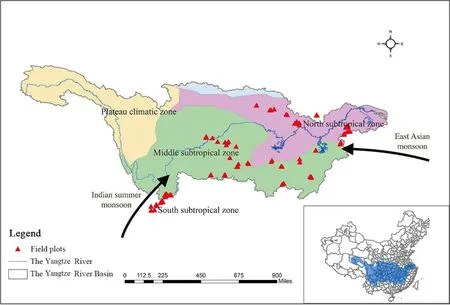
Fig.1 Study sites of reforested lands in the Yangtze River Basin.A total of 150 plots were sampled across the North,Middle and South subtropical zones
To estimate biomass carbon,at each site a minimum of three trees in three 10 m×10 m plots were sampled for height and diameter at breast height (dbh),species and location.In addition,the biomass of undergrowth plants,including shrubs and herbaceous plants was calculated.With shrubs,stems were measured at ground level.One subplot(1 m×1 m) was randomly established in each plot to measure litterfall biomass (Ngo et al.2013).
An auger was used to collect soil samples to measure organic carbon and bulk density at depth intervals of 0-20,20-40 and 40-60 cm from three 1 m×1 m subplots in each site.The carbon stock of cropland was set as the baseline for calculating the rate of carbon sequestration in the restoration process after cropland conversion into forests.Therefore,soil samples of adjacent croplands were also collected to compare sites.All the samples were transported to the laboratory for analysis.Soil samples were air-dried,hand cleaned to remove woody debris and charcoal,visible soil organisms and stones,and weighed.Air-dried soil samples were sieved through a 2-mm and gravel (> 2 mm) were weighed.The carbon content of the soil samples was measured using a TOC (total organic carbon) analyzer.Bulk density was calculated based on the soil volume of cores in samples,the mass of dry soil<2 mm,and large organic matter fragments.Using the bulk density of each depth in each plot,soil carbon density was calculated.
To compare these estimates by vegetation type,the trees were divided into evergreen species (Chinese fir,pine,camphor,spruce and eucalyptus),deciduous species (poplar and ginkgo),and economic species (apple,peach,orange,mango and arbutus) (Hou et al.2020a).The analysis by vegetation type advances understanding of their contribution to carbon accumulation in reforested lands.To compare the carbon sequestration rate of forests with different stand ages in our samples,trees were divided into young forests (<20 years),and mature forests (> 20 years),since these are the age groups used by China’s State Forestry Administration (SFA).
Biomass and carbon estimation of the trees
Aboveground biomass (AGB) of trees at each site was calculated using allometric equations to convert height and diameter to biomass based on Chave et al.(2004) who assessed sources of error associated with AGB estimates from forest inventories and improved the allometric model to estimate the AGB of large trees.The equations were highly precise (model efficiency > 80%) and allometric equations were readily available.However,using the allometric model developed for large trees to estimate biomass of small trees and shrubs may overestimate or underestimate their actual biomass due to their restriction from the DBH range and differences in growth forms and physiognomies (Litton and Boone Kauffman 2008).For this reason,the biomass equation based on stem diameter was also used (Heng et al.2014):

where AGB=estimated aboveground biomass in kg dry mass,ρ=wood density,D=diameter at breast height (cm)andH=height (m).Wood density was provided from the China Forestry Administration Database.The biomass was expressed in t ha-1.
To estimate undergrowth biomass,the undergrowth samples were divided into aboveground and belowground portions.Samples were weighed,dried at 65°C for 48 h before determining dry weight.Undergrowth biomass was added to the aboveground and belowground biomass to calculate total biomass.For belowground biomass density,the following equation based on default values in subtropical humid forests was used (FAO 2015):

where BGB density=belowground biomass density (t ha-1),AGB density=aboveground biomass density (t ha-1),DV=default value for calculating belowground biomass density from aboveground biomass density (%).DV=0.2 for AGB<125 t ha-1,and 0.24 for AGB > 125 t ha-1.
Biomass carbon was estimated where wood cellulose is assumed to be 45% C by weight,with a C/N ratio of 100.Carbon in total biomass (AGB carbon density+BGB carbon density) was estimated and expressed as Mg C ha-1.
Soil organic carbon (SOC) stock estimation
SOC stocks were estimated using the SOC content of soil samples at different depths and the bulk density of each depth.SOC density was calculated using Eq.4 (Guo and Gifford 2002):

whereBDis soil bulk density (g cm-3),SOC soil organic carbon content (g kg-1);SOC density is SOC density of different land uses (Mg C ha-1);Dis soil depth (cm).
Total carbon density of each site was estimated using Eq.5:

Carbon sequestration estimation under the ‘Grain for Green’ reforestation
The change in carbon sequestration was calculated following the ‘Grain for Green’ reforestation of croplands.A linear regression equation was constructed to estimate the relationship between carbon sequestration rates and stand age as follows:
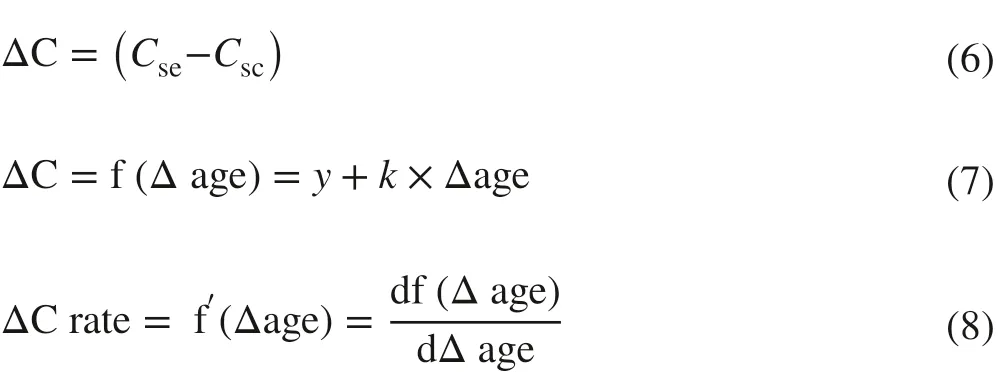
where ΔC is change in carbon stock (Mg C ha-1),Cseis mean carbon density in afforested sites (Mg C ha-1),Cscis mean carbon in adjacent comparison sites (Mg C ha-1);yis a constant,Δage the time interval (years),kis the slope of the regression line,ΔC rate is the carbon sequestration rate(Mg C ha-1a-1).
Tree species diversity estimation
The Shannon-Wiener species diversity index (Eq.9) was used to quantify species diversity at each site (Magurran 2004).This diversity index accounts for both species richness and evenness,which are important factors in biodiversity productivity studies (Zhang et al.2012b).

whereP iis the proportion of basal areas of theithspecies and s is the number of species.
Statistical analyses
Statistical analyses were performed using SPSS (version 22 SPSS Inc,Chicago,IL,USA).Linear regression analysis was used to develop the functions of carbon sequestration after reforestation,and linear mixed-effect models to examine the fixed and random effects of factors on carbon sequestration.Pearson’s correlation analysis analyzed the relationships of carbon storage following reforestation with stand age,mean annual temperature and precipitation,longitude,latitude and altitude.The mean value for each categorical classification was calculated with a bias-corrected 95%confidence interval using T-test analysis.The distribution patterns of biomass carbon density and SOC density were analyzed in ArcGIS software using provincial boundaries and climate zone boundaries downloaded from the Resource and Environment Data Cloud Platform (http://www.resdc.cn/data.aspx?DATAID=200).
Results
Carbon storage in aboveground,belowground and undergrowth biomass
Estimated biomass carbon and site characteristics are shown in Table 4 and Fig.2.The age of most trees was less than 40 years as the sites were reforested as part of the ‘Grain for Green’ project.Biomass carbon ranged from 7.9 to 565.1 Mg C ha-1with a site-average of 87.1±78.7 Mg C ha-1(p<0.05) (Table 4).Site-averaged biomass carbon in AGB and BGB were 73.3±65.6 Mg C ha-1(p<0.05) and 13.9±13.1 Mg C ha-1(p<0.05),respectively.Site-averaged biomass carbon by vegetation type,from high to low,is:ecological species (evergreen and deciduous) and economic species (Table 1).Ecological evergreen species had a carbon density approximately twice that of economic species(Table 1).Maximum carbon density was found in Chengjiang County in Yunnan province in the upper reaches of the YRB (Table 4),while the lowest densities were in Anhui province (Table 4).

Table 1 Biomass and soil density (Mg C ha-1) in different vegetation types
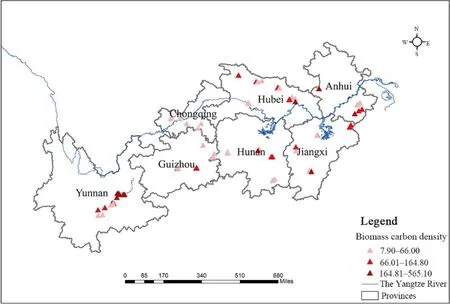
Fig.2 Spatial patterns of biomass carbon density (Mg C ha-1);there is an insignificant spatial heterogeneity of biomass carbon density
Carbon storage in soils
Estimated SOC density and characteristics of sites are shown in Table 5 and Fig.3.Site-averaged SOC densities(zero to 60 cm) were 111.3±93.6 Mg C ha-1(p<0.05)with most densities between 100 and 200 Mg C ha-1.SOC densities ranged from 20.8 to 689.0 Mg C ha-1among the sites (Table 5).In addition,SOC of the three sampled soil layers (zero-20 cm,20-40 cm and 40-60 cm) decreased significantly (p<0.05) with increasing depth at most sites.The site-averaged SOC in the zero to 20 cm,20-40 cm and 40-60 cm layers were 52.3±36.9 Mg C ha-1(p<0.05),34.5±35.0 Mg C ha-1(p<0.05) and 24.9±30.4 Mg C ha-1(p<0.05),respectively.
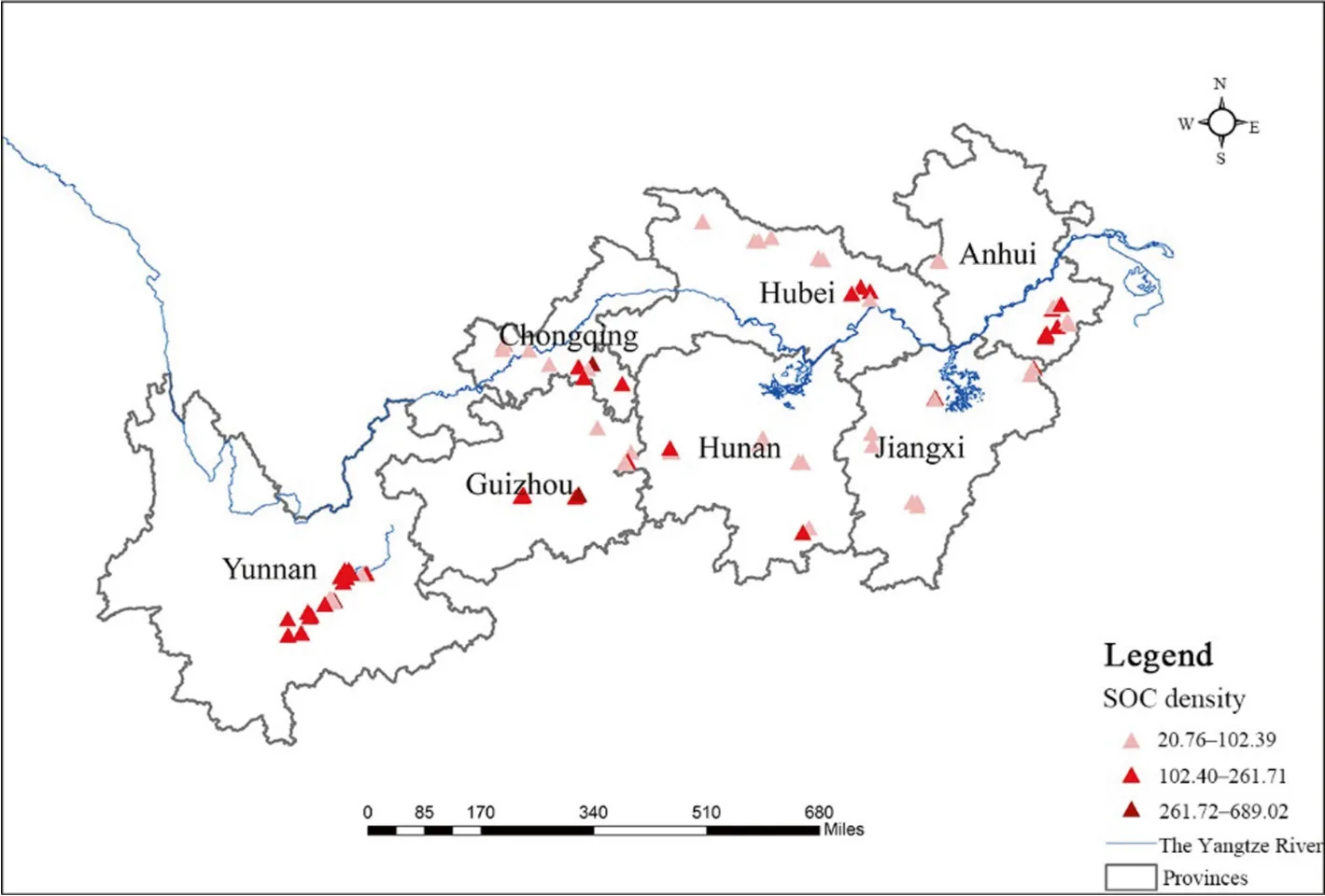
Fig.3 Spatial patterns of SOC density at study sites (Mg C ha-1).SOC=soil organic carbon,SOC density increases significantly (p<0.05) with decreasing longitude and latitude
Site-averaged SOC densities were greater than biomass carbon densities in most sites (Tables 4 and 5).Among the types of vegetation,and similar to biomass,the siteaveraged SOC of evergreen species was the highest while that of deciduous trees the least (Table 1).Moreover,carbon storage by ecological species was signif ciantly (p<0.05)higher in both soil and vegetation than that of economic trees(Tables 4 and 5).The maximum density occurred in Kaili county of Guizhou province,while the lowest occurred in Xinjian county of Jiangxi province (Table 5).
Carbon sequestration in biomass and soil after reforestation
Biomass carbon had a significant (p<0.01) and positive trend from the ≤10 year plantings to the 30+age stand.AGB carbon was highest in the 20-30 age stand and almost four times that of the ≤10 year seedlings (Fig.4).Biomass carbon increased rapidly from this stand to the 20-30 year stand and then the rate of carbon sequestration declined slowly to the 30+years stand (Fig.4).SOC in the 30+age stand was the highest of all age groups,while the 10-20 year group was the lowest (Fig.4).In addition,SOC density decreased with soil depth for all stands.In the upper 20 cm layer,it was higher than in the 20-40 cm depth,which was higher than in the 40-60 cm layer (Fig.4).In general,SOC density was significantly higher (p<0.01) than biomass carbon (Fig.4).Compared to cropland sites,carbon in the upper 20 cm layer significantly increased (p<0.01) with stand age(Fig.4).Overall,total carbon density (biomass carbon and SOC) increased significantly with stand age.Vegetation and soil both contribute to carbon accumulation after the conversion of cropland to forest.
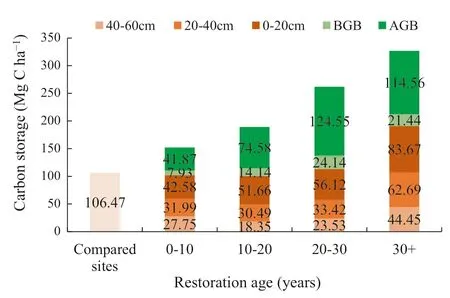
Fig.4 Carbon storage in biomass and soil and compared cropland sites in four stand age groups;AGB=aboveground biomass,BGB=belowground biomass
The dynamics of carbon sequestration differ in biomass carbon and soil carbon.Biomass carbon increased at a rapid and significant rate for stands younger than 20 years while for older stands,it increased at a slower rate (Table 2).The carbon sequestration rate for stands<20 years is more than twice the rate for all stands (Table 2).This indicates that carbon accumulates rapidly in young stands and increases slowly in mature forests.However,in contrast with biomass,the rate of SOC sequestration is significantly higher in older stands (Table 2).Overall,the rate of total carbon sequestration is higher in younger stands (Table 2).For all stand ages in our study sites,the rate of biomass carbon accumulation is higher than the rate of sequestration in the soils (Table 2).More carbon accumulates in biomass in younger stands but as the forest ages,more carbon is sequestered in the soil.In our study,stand age had significant effects on biomass carbon sequestration (p<0.01) and SOC sequestration(p<0.05) (Tables 6 and 7).The estimates of biomass carbon sequestration and SOC sequestration were 3.0 and 1.3 Mg C ha-1a-1(Tables 6 and 7).Biomass carbon sequestration varies by province;Anhui,Chongqing,Guizhou,and Hunan provinces had significantly lower rates of accumulation than Yunnan province (Table 6).However,there were no significant differences in soil carbon sequestration by provinces(Table 7).
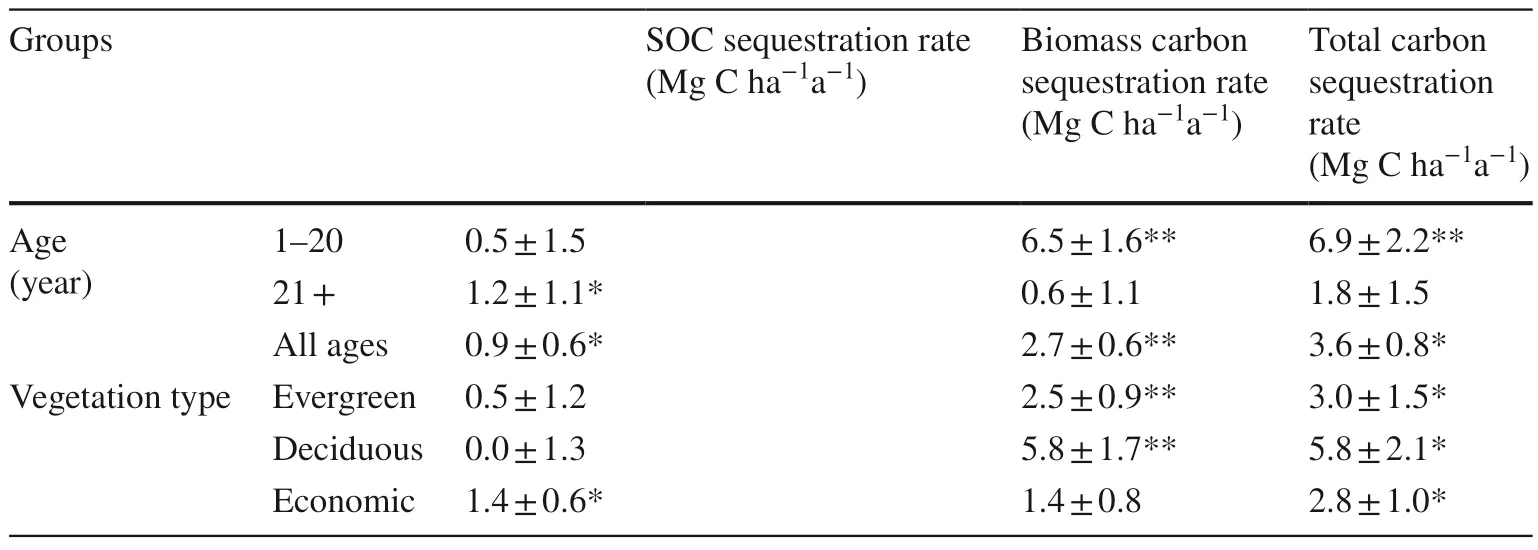
Table 2 Rates of carbon sequestration in biomassand soil,and total carbon in different aged stands and cover types from croplands to forests
Carbon sequestration rates by biomass and soil also vary by vegetation or cover type (Table 2).There was a positive and significant relationship between total carbon sequestered and stand age (Table 2).Total carbon sequestered of the three types of species were:ecological deciduous species > ecological evergreen species > economic species(Table 2).In terms of biomass carbon,carbon sequestered in deciduous and evergreen species was significantly positive by age,while the carbon sequestration rate by economic species was insignificant (Table 2).Similar to the total carbon sequestered,biomass carbon sequestered for the three types of species was:deciduous species,evergreen species and economic species (Table 2).Thus,our results show that deciduous and evergreen species increased carbon storage in biomass more than economic species.Soil carbon under economic species increased significantly while it was insignificant under evergreen and deciduous species (Table 2).However,the fix effects on biomass carbon sequestration and SOC sequestration were insignificant (p> 0.05) by ecological evergreen and deciduous species,and by economic species (Tables 6 and 7).There is no significant mixed-effects by province,vegetation type and stand age on carbon sequestration.
Relationships between carbon sequestration and environment
Stand age and altitude have signif ciant,positive correlations with biomass carbon sequestration (Table 3).Although both AGB and BGB carbon were significantly correlated with stand age and altitude,the correlations were stronger for AGB carbon (Table 3).In addition,AGB carbon and BGB carbon were not significantly correlated with mean annual temperatures,mean annual precipitation,longitude or latitude (Table 3).
Stand age had a positive,significant correlation with carbon sequestration in the top 20 cm soil layer (p<0.05)(Table 3).The significance of the correlation decreased with increasing depth (Table 3).Soil sequestration and the 20-40 cm and 40-60 cm soil layers were not correlated(Table 3).Latitude was negatively correlated with SOC(40-60 cm) while longitude,altitude,MAT and MAP had insignificant correlations with SOC (Table 3).
Compared to SOC,biomass carbon sequestration was more correlated with stand age and altitude (Table 3).However,carbon sequestration in either biomass or soil was not correlated with MAT and MAP (Table 3).SOC(40-60 cm) increased as longitude and latitude decreased,while biomass carbon accumulation was not correlated with either (Table 3).This indicates that SOC sequestration in deep soil is greater in the southwest corner of the basin.
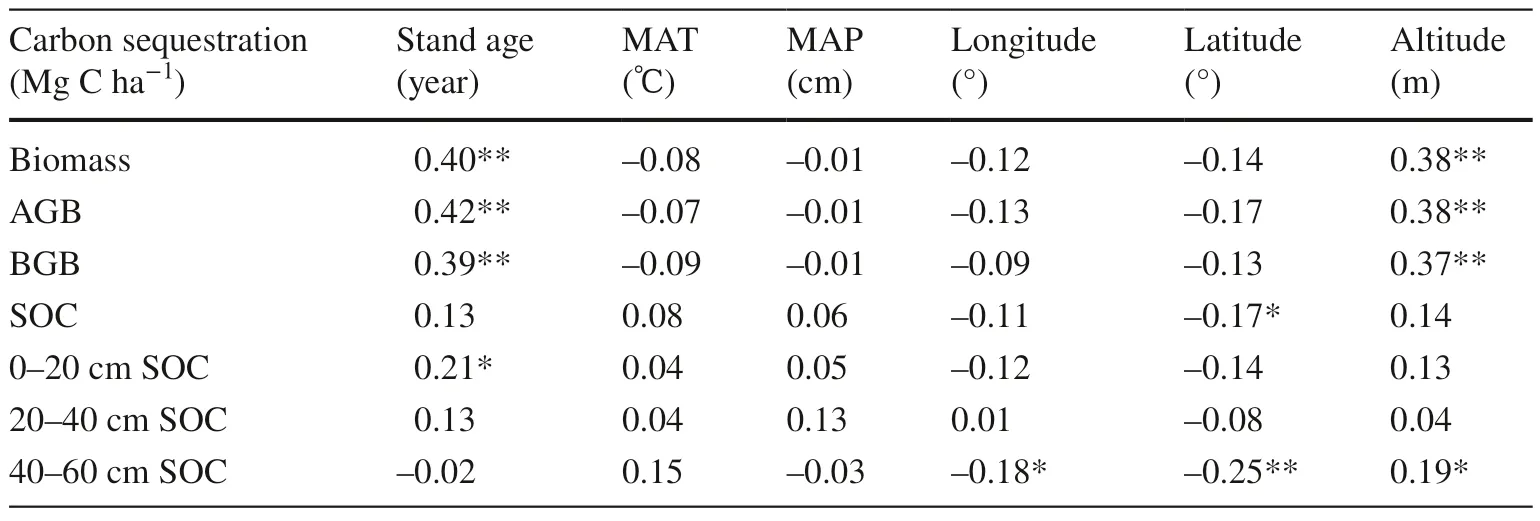
Table 3 Pearson correlations of carbon sequestration with stand age,mean annual temperature (MAT),mean annual precipitation (MAP),longitude,latitude and altitude.AGB=aboveground biomass,BGB=belowground biomass,SOC=soil organic carbon
Relationships between carbon sequestration and plant species
According to our results,the average biomass carbon density in multiple species (with an average of 83.5 Mg C ha-1) is more than that in a single species (with an average of 79.2 g C ha-1).Species diversity has significant effects on both AGB and BGB carbon,and with the increase in the number of plant species,biomass carbon showed a decreased trend(Table 8 and Fig.5).In the soils,carbon density in multiple species (average of 112.8 Mg C ha-1) was almost the same as that in a single species (average of 115.0 Mg C ha-1).Unlike biomass carbon,the diversity of species did not affect soil carbon density and SOC sequestration.
Discussion
Effects of stand age on carbon sequestration
The results show that biomass carbon increased rapidly in younger stands and decreased in stands over 100 years(Rothstein et al.2004;Taylor et al.2007).Fonseca et al.(2011) also found that biomass carbon accumulation was positively correlated with the age of secondary succession vegetation and that the increase was fastest during the first 10 years.Dixon et al.(1994) reported that young forests sequestered CO2at higher rates than most other ecosystems and stored more in the wood.The classic stem-respiration explanation for carbon accumulation in younger forests is that accumulation accelerates as canopies develop.After maximum leaf area is attained,respiration costs increase to sustain the woody characteristics of mature forests(Barns et al.1998).Binkley et al.(2002) supported another hypothesis in that part of the age-related decline in carbon accumulation in forest growth is due to competition-related changes in stand structure and the resource-use efficiencies of individual trees.Some studies support the idea that the significant decline in carbon accumulation in older stands could be due to declining productivity (Gower et al.1996;Ryan et al.1997).
Our results showed a positive correlation between soil organic carbon sequestration and stand age,especially in the top 20 cm soil layer.Carbon sequestration in the soils are slower under the younger aged stands than under the older stands.Previous studies reported a positive correlation between soil organic carbon and stand age (Li et al.2012;Deng et al.2014).Hou et al.(2019a) found that stand age had significant effects on soil carbon storage,especially in the upper soil layers,which is consistent with our results.Conversion from cropland to forest had a positive effect on soil carbon stocks (Laganiere et al.2010;Bárcena et al.2014).The rate of SOC sequestration was initially slow after planting because there was carbon loss from the soil pool when cropland is converted to forest since cropland soils contain roots with accumulated carbon (Li et al.2012).The small amount of litter in young forests also reduces the carbon input to soil and results in a slow sequestration rate(Liu et al.2014).The increased SOC sequestration in mature forests might be attributed to the fact that older trees allocate more nutrients and water resources to roots than younger forests.In our sampling sites,most trees are<50 years old with a biomass of 87.1±78.7 Mg C ha-1which is significantly lower than the biomass of China’s forests that are over 100 years old (104.7±30.3 Mg C ha-1) (Xu et al.2018).The large proportion of newly established forests in the YRB suggests the substantial potential for carbon sinks in the future,considering the increase of forested area and the relationship between carbon sequestration and stand age.Ecological conservation programs such as the ‘Grain for Green’ program have stimulated carbon uptake into vegetation and increased soil carbon sequestration in China’s terrestrial ecosystems (Lu et al.2018).
Effects of vegetation type on carbon storage and sequestration
The type of vegetation cover influences biomass carbon because of variations in carbon inputs such as productivity and belowground carbon allocation,while soil carbon accumulation is affected by carbon inputs from litter.Carbon loss is affected by soil respiration,volatilization of organic compounds,and fire (Lugo and Brown 1993;De Deyn et al.2008;Laganiere et al.2010;Pérez-Cruzado et al.2012).Our results show that deciduous species sequester more carbon.This is most likely because deciduous species are affected more by climate than evergreen species(Hou et al.2019a).Moreover,soil organic carbon changes more for evergreen species and economic species than for deciduous species.Economic species contributed more to SOC accumulation than ecological species,which may be due to increased organic matter input with applications of fertilizer and manure,since farmers apply more fertilizer to economic species than to ecological ones.Evergreen species maintain stable production throughout the year,which reduces negative effects of climate change and induces more carbon storage in soil (Hou et al.2019a).In addition,Jobbágy and Jackson (2000) found that root distribution affected the vertical placement of SOC.Evergreen species usually have more deeply anchored root systems than the other species,which enables them to accumulate carbon in soil (Jobbágy and Jackson 2000).Inconsistencies with our results and those from other regions may be due to differences in climatic conditions.Tolunay (2011) reported that carbon density was highest in deciduous forests in Turkey with a value of 154.7 Mg C ha-1.Some studies also found that deciduous trees have high SOC sequestration (Bárcena et al.2014;Deng et al.2014; Liu et al.2018).Hou et al.(2019a) suggested that evergreen species accumulated more soil carbon years after reforestation.Our results differ from studies that found that converting cropland to deciduous forests had a greater effect on soil carbon stocks than conversion to evergreen forest.Dissimilarities in soil carbon can be attributed to differences in biomass allocation strategies and litter quality between deciduous and evergreen species.For example,higher belowground biomass should result in higher carbon inputs from the roots (Laganiere et al.2010).However,differences in SOC are also caused by differences in litterfall inputs and decomposition by species,which is mainly controlled by litter quality (Hobbie et al.2007;Hou et al.2020a).
Effects of environmental conditions on carbon sequestration
The Grain for Green reforestation program focused on western China because that region contains the headwaters of the Yangtze and Yellow rivers and accounts for about 80% of the total area with soil erosion problems (Liu et al.2008).Similar to our results,a greater amount of carbon was stored in southwestern China than in eastern China (Tang et al.2018).Southern China accounts for more than 65% of the country’s total carbon pool (Lai et al.2016).Valentini et al.(2000) also showed that the southern warm forests sequestered more carbon than the northern cool forests.Our study finds that mean annual temperatures and precipitation had no significant correlation with carbon sequestration in either vegetation or soil.High temperatures contribute to higher net primary productivity and higher carbon accumulation in biomass than in soil.However,in the subtropical regions,the climate may stimulate decomposition which reduces SOC stocks.Soil disturbances in the initial stages of cropland conversion reduce SOC stock and affect the relationship between climate and SOC (Hou et al.,2020c).Our results agree with other studies which found no significant correlation of soil carbon with temperature and precipitation(e.g.,Omoro et al.2013;Song et al.2014).Correlations of carbon sequestration with temperature and precipitation in other studies may be attributed to differences in study area and climatic conditions.However,these studies recognized that soil depth had a significant effect on soil organic carbon which decreased with depth (Howlett et al.2011;Deng et al.2014;Justine et al.2015).
Effects of plant diversity on carbon stock
In this study,numerous species were sampled.Carbon density and sequestration varied with the species component within different sites.Plant diversity has effects on carbon stock in forest ecosystems (Zhang et al.2012).Positive relationships between plant diversity and aboveground biomass have been found in numerous studies (Zhang and Chen 2015;Ali and Mattsson 2017;Ali and Yan 2017).Plant diversity influences the efficiency of resource use and enhances plant productivity and biomass (Tilman et al.2001;Zhang and Chen 2015),since different tree species have different requirements for nutrients from soil and water.This results in greater accumulation of biomass (Ali et al.2016) and plant diversity is a major driver for variations in aboveground carbon storage in secondary subtropical forests.The plants may grow rapidly and their productivity increases with increasing soil nutrients,however high soil nutrients may also lead to increased competition (Quesada et al.2012;Prado-Junior et al.2016).High soil fertility may lead to low biomass productivity,possibly because of nutrient imbalances in the soil (Prado-Junior et al.2016).Future work should take record plant diversity to better understand its effects on carbon sequestration.
Carbon accumulation after reforestation
Both vegetation and soil play important roles in carbon sequestration in ecosystems.However,our study found that site-averaged carbon density of soil was higher than biomass carbon.Similarly,Fonseca et al.(2011) concluded that carbon stored in soil was greater than carbon stored in biomass for all stand ages.Some studies found that SOC storage was between 50 and 80% higher for total forest carbon than biomass carbon (Jandl 2006;Tang et al.2018).Forests in the YRB are highly productive which results in high carbon accumulation (Zhang et al.2014).
In croplands,irrigation and fertilization transfer carbon to grain,which is harvested,consumed,and eventually released back into the atmosphere (Génard et al.2008).In contrast,carbon in forests is allocated to woody tissues and stored longer as they have a slow turnover rate (Schulze et al.2000).Moreover,roots and litterfall also contribute to soil organic carbon accumulation (Schulze et al.2000).Although soil organic carbon density is greater than biomass carbon density,species in new reforestation programs sequester more carbon per year in biomass than soils (Hou et al.2020b).Liu et al.(2014) found that a large proportion of fixed carbon is stored in biomass while only 2.7%accumulates in soil at a national scale.In the future,SOC sequestration will increase faster than biomass carbon since biomass carbon increases slowly.In this study,it was also found that SOC accumulated quickly in the 20-cm soil layer.Similarly,Veldkamp et al.(2003) reported that land use changes primarily modified top soil layers.
Specific to our project,some studies have estimated the amount of carbon sequestered by the reforestation programs.Lu et al.(2018) showed that forest restoration increased the annual carbon sink by 74.0 Tg C a-1in regions where ecological projects were implemented.Chen et al.(2009) estimated that by 2010,carbon sequestration increased 12.5.Tg C in Yunnan province due to the Grain for Green program.Land use changes in southern China have increased standing aboveground carbon stocks by 0.11 Pg C a-1during 2002-2017,most of which was contributed by newly established forests (32%) rather than existing forests (24%) (Tong et al.2020).The ecological programs have had a significant effect on carbon stocks in China’s terrestrial ecosystems,which will continue in the future (Hou et al.2019b).
Conclusions
Changes in biomass carbon and soil organic carbon following reforestation differ greatly by stand age and cover type in the YRB.Site-averaged soil organic carbon was greater than site-averaged biomass carbon,while there was more carbon sequestered in biomass than in soil.Biomass carbon accumulated rapidly in the first 20 years while older forests accumulated carbon more slowly.Conversely,soil organic carbon sequestration rate increased rapidly in older forests.In addition,evergreen species have greater carbon density in both biomass and soil than deciduous and economic species.Ecological species accumulated more biomass carbon than economic species while carbon sequestration in soil was greater for economic species than for ecological ones.Our findings on the relationship of carbon storage with climate,stand age and plant types provide relevant information for the potential for carbon storage after reforestation in the YRB.Optimizing reforestation practices can improve carbon sequestration in reforested lands.
AcknowledgementsWe are very grateful to the farmers who helped us in the field.We would like to thank the lab staffof the Inner Mongolia Key Lab of River and Lake Ecology,Inner Mongolia University,for their support with the soil analyses.
Appendix
See Fig.5 and Table 4,5,6,7,8.

Table 6 Estimate of fix effects on biomass carbon sequestration.Biomass carbon is a dependent variable.Province,vegetation type and age(covariate) are factors
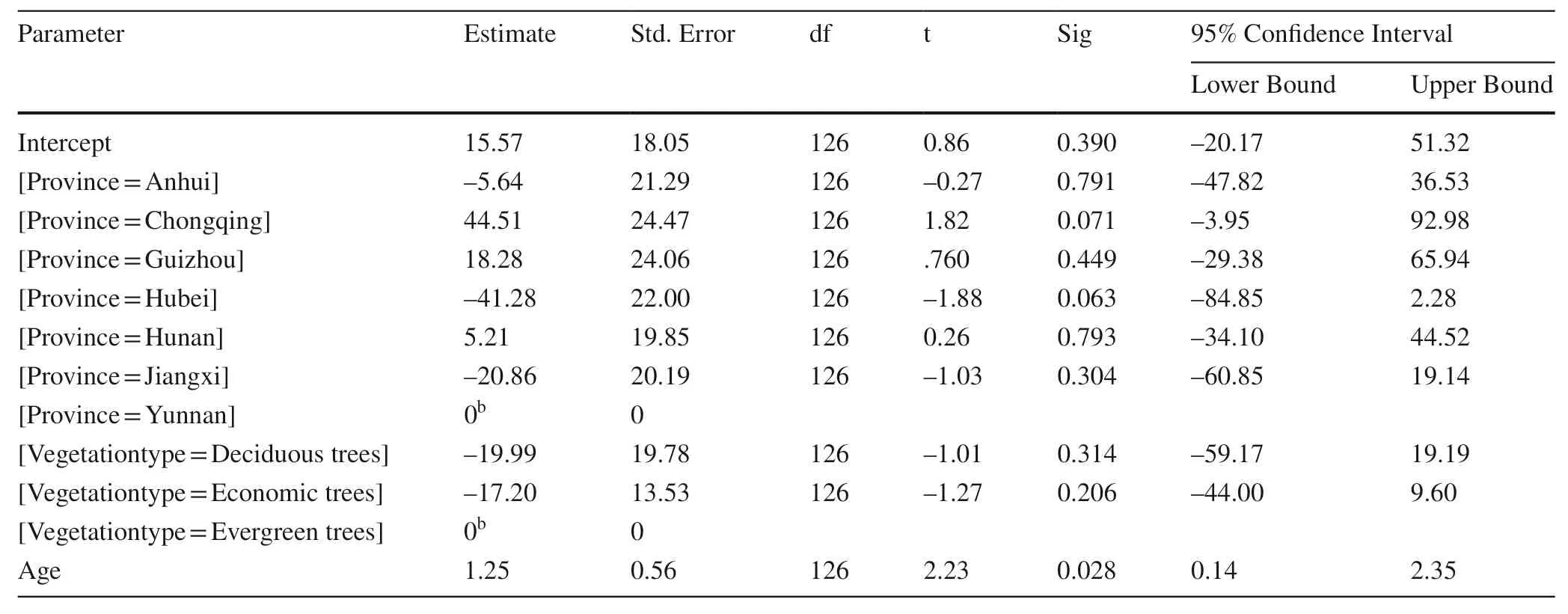
Table 7 Estimate of fix effects on SOC sequestration.SOC sequestration is a dependent variable.Province,vegetation type and age (covariate)are factors

Table 8 Model Summary and Parameter Estimates(Dependent Variable:biomass density)
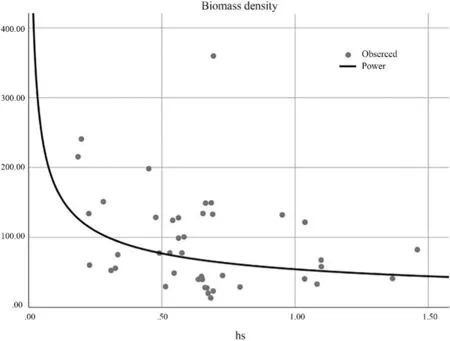
Fig.5 Biomass density variations with plant species diversity
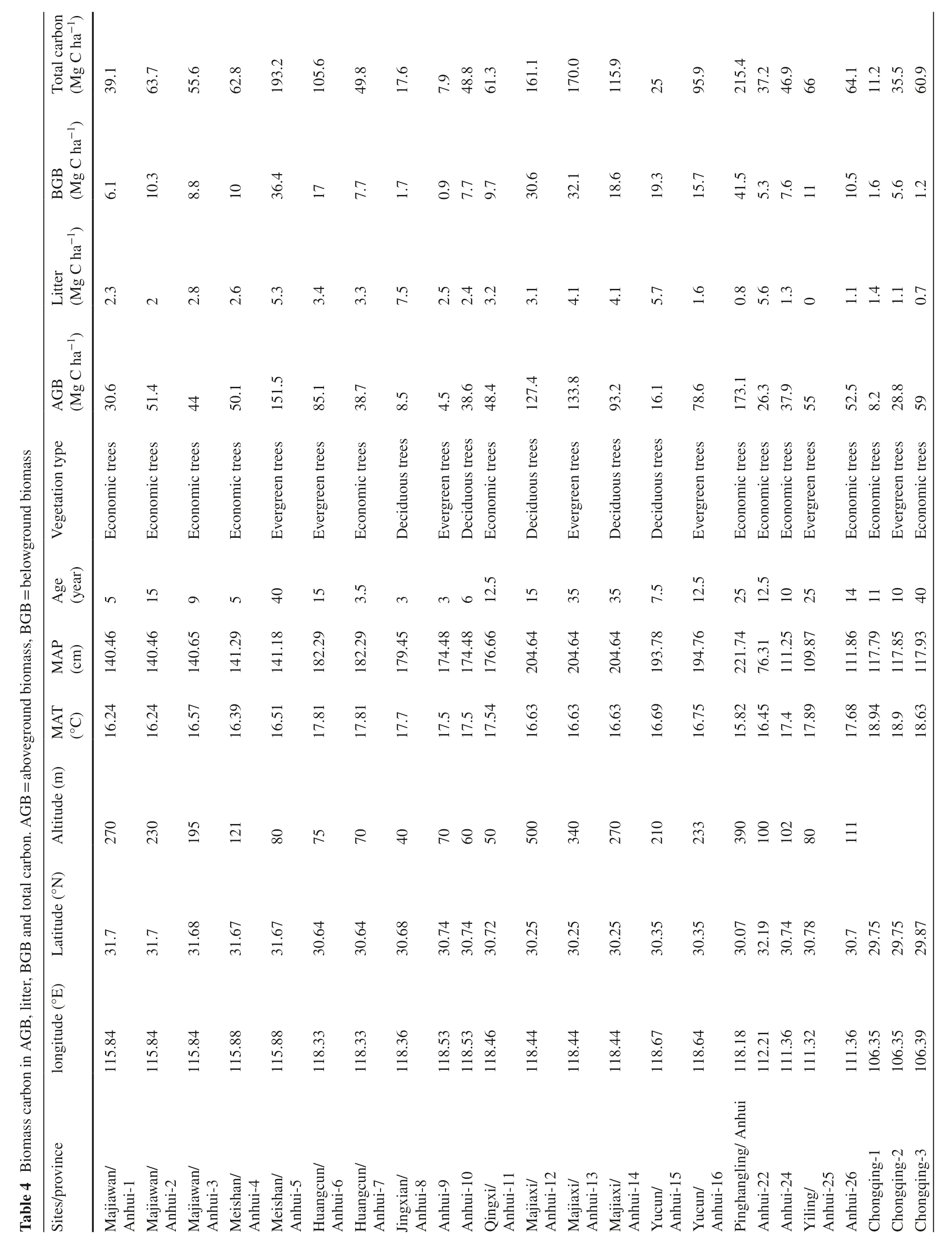
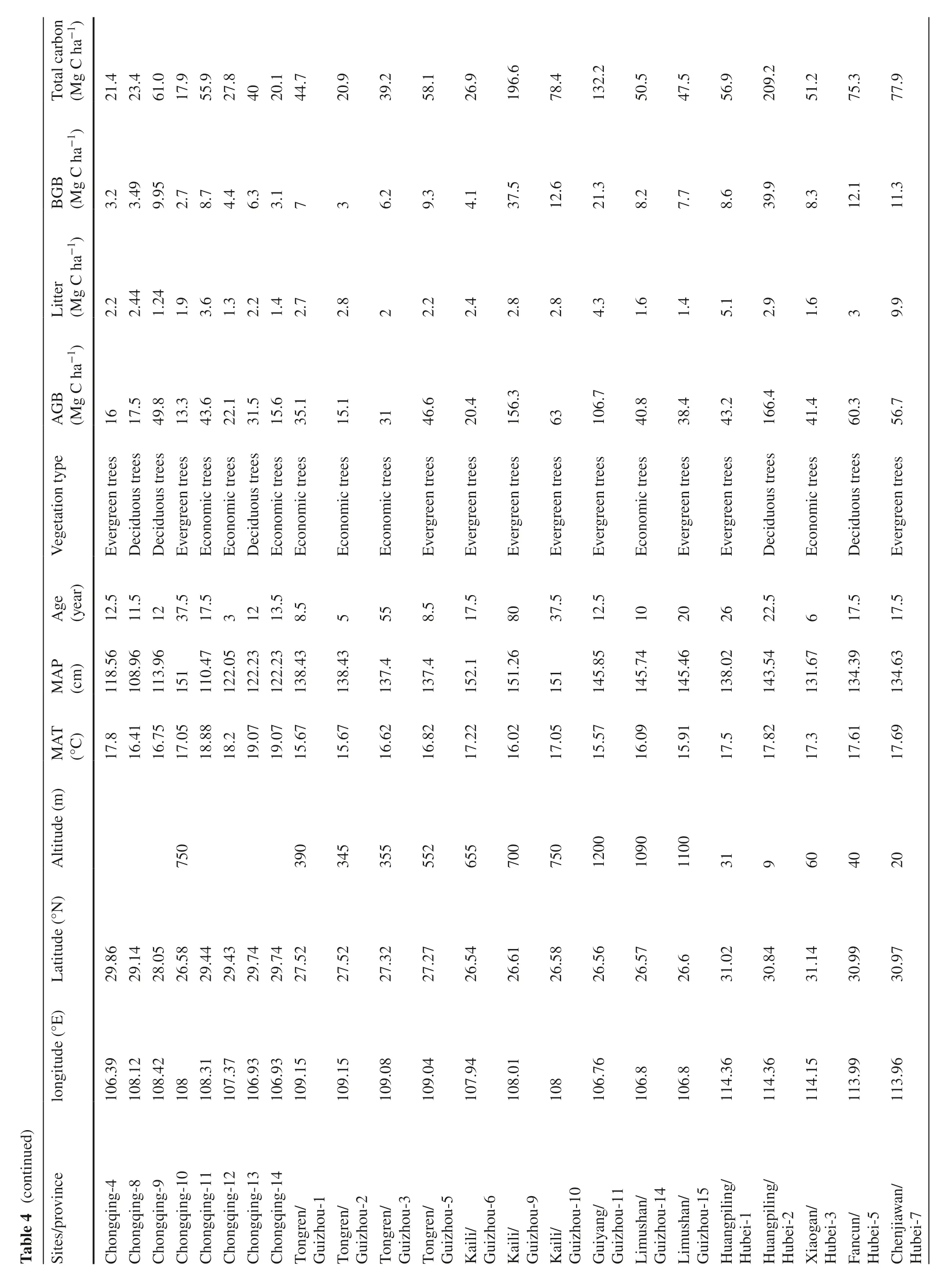
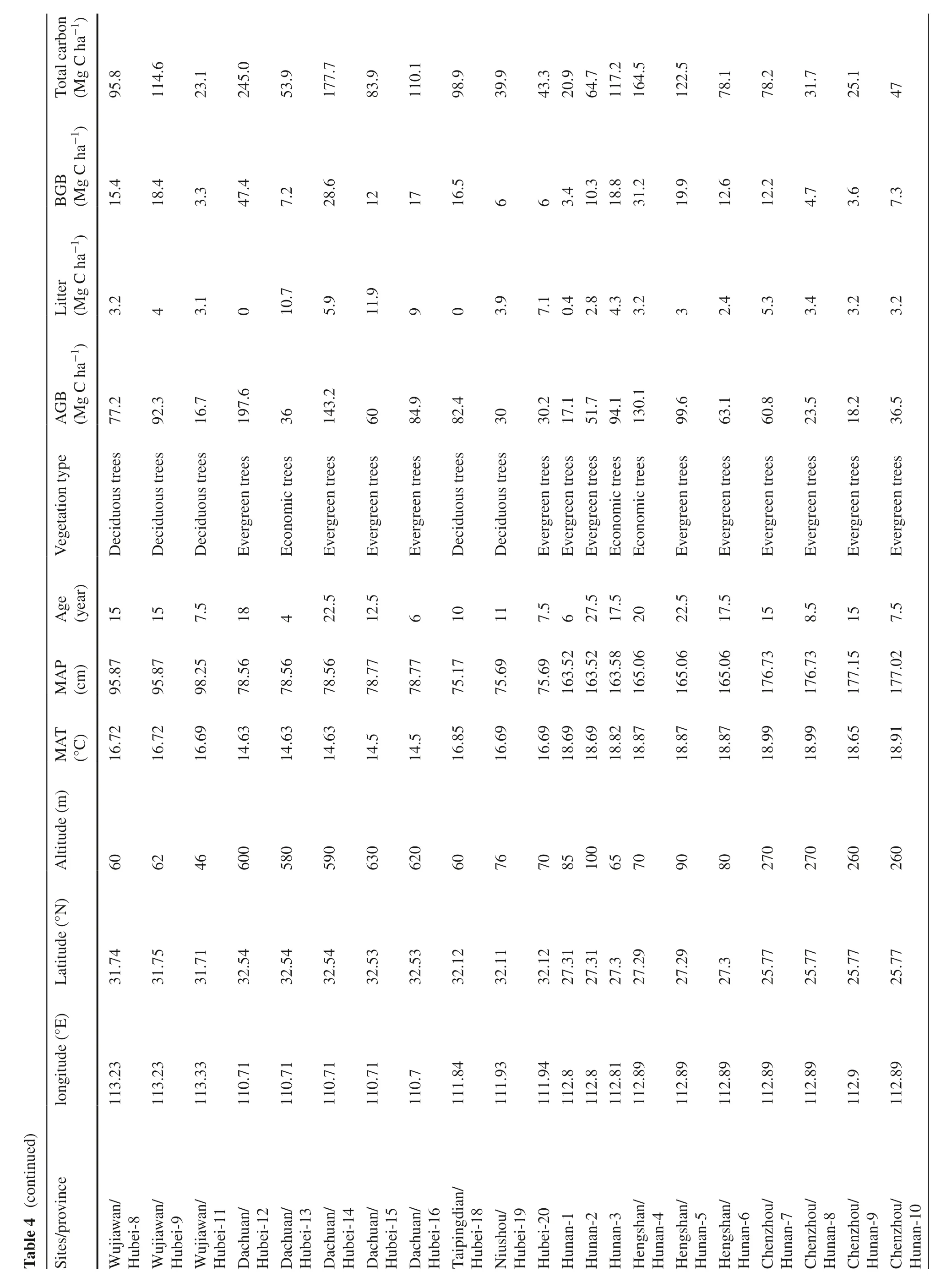
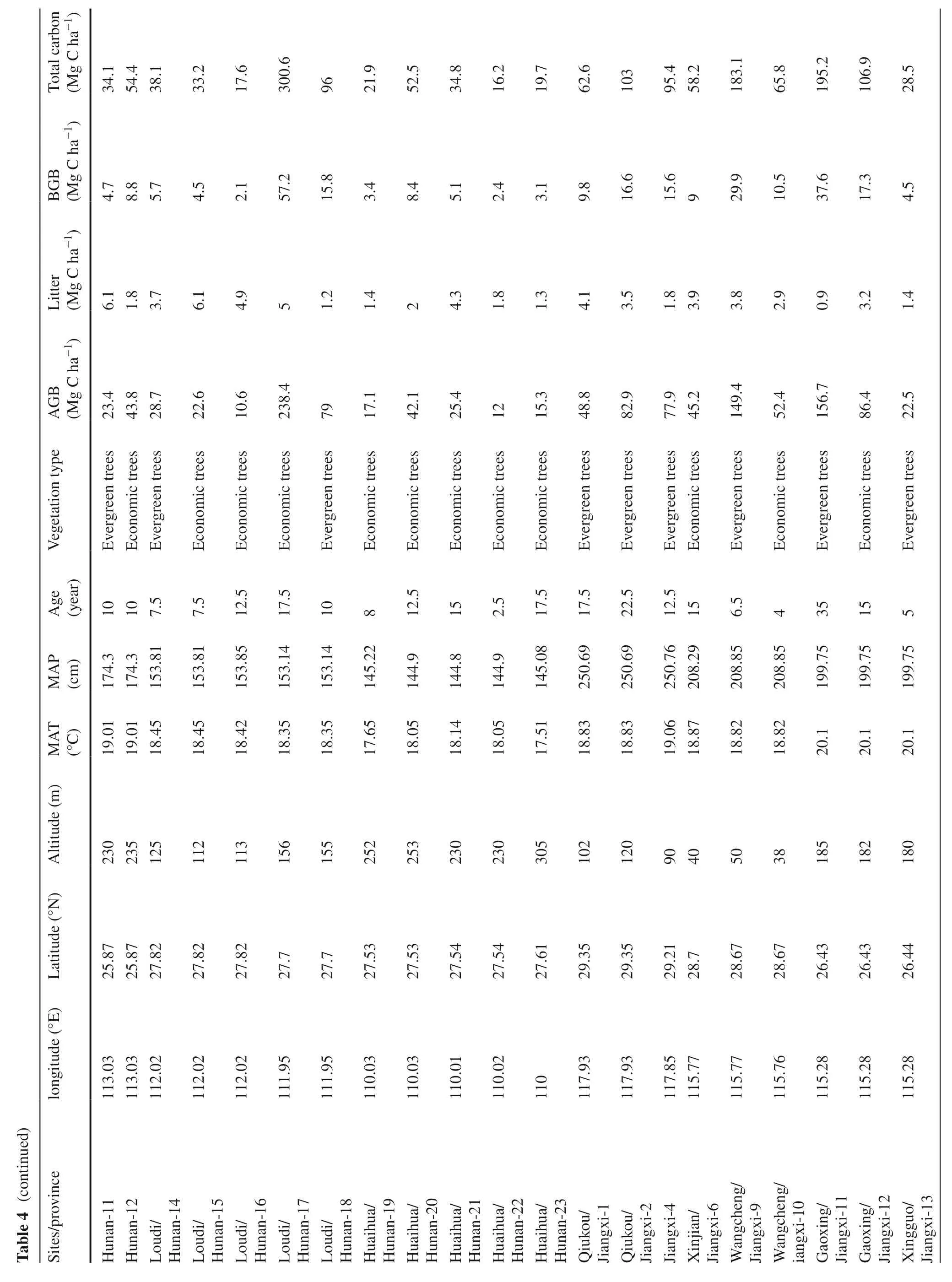
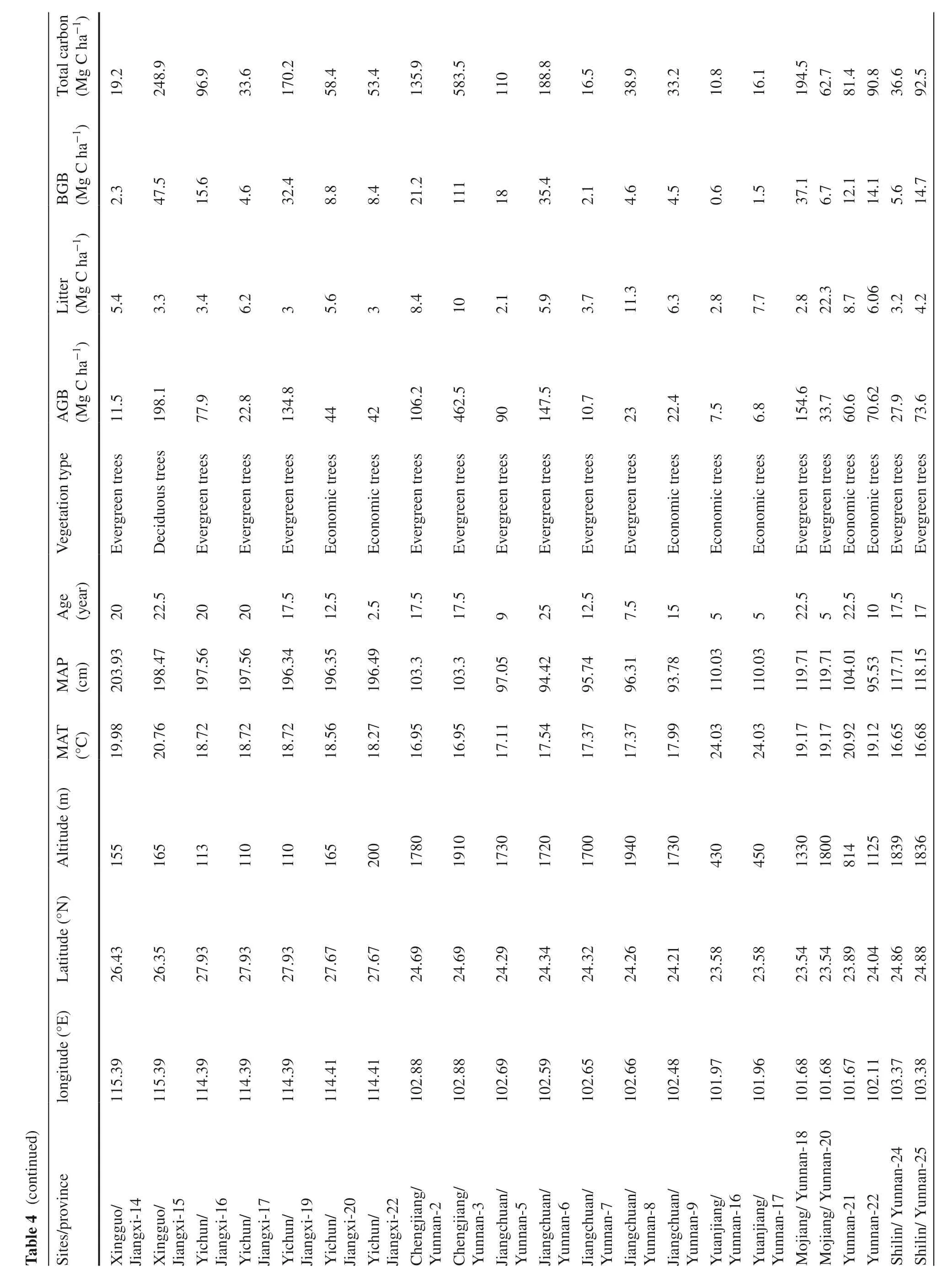

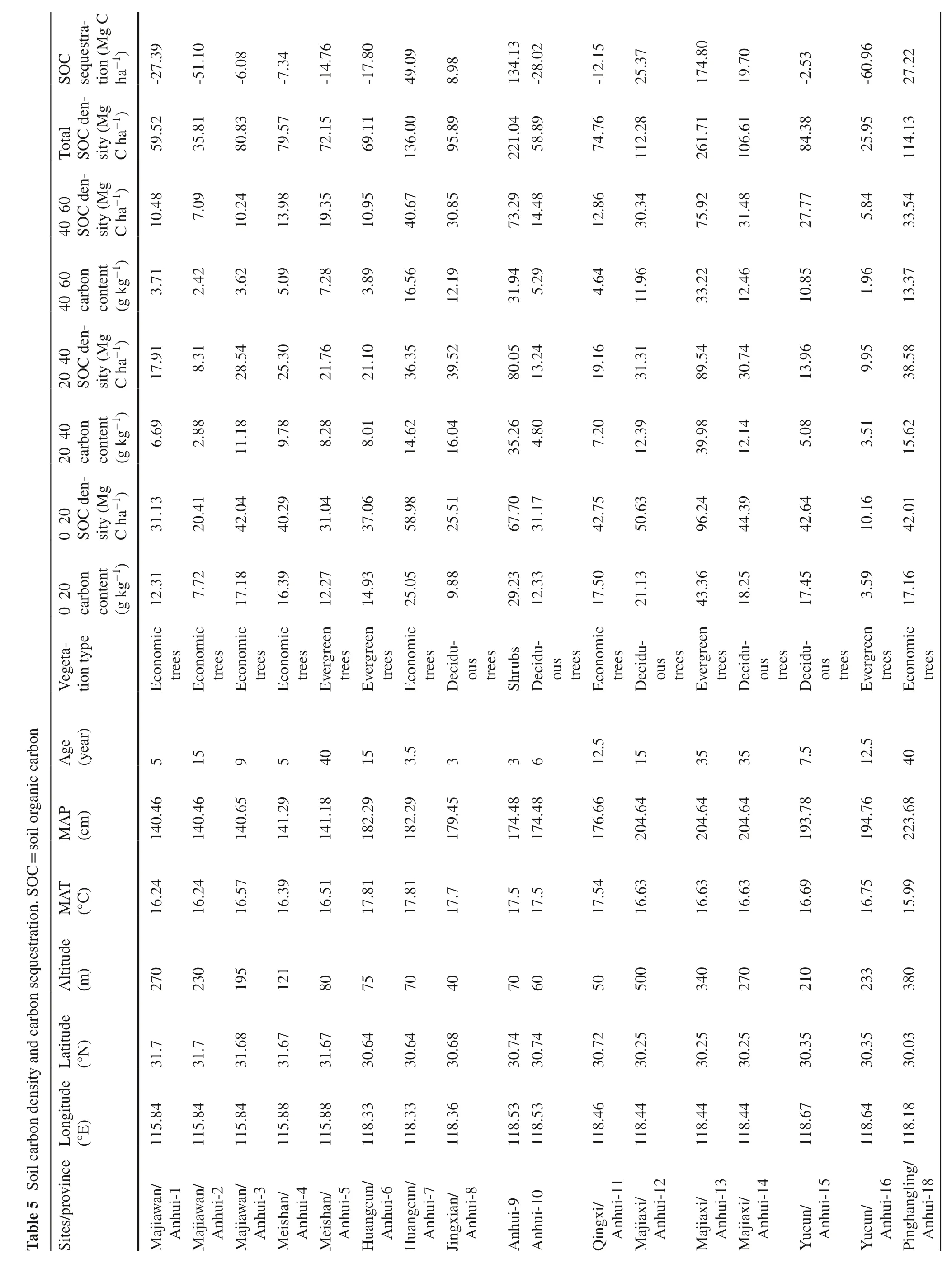

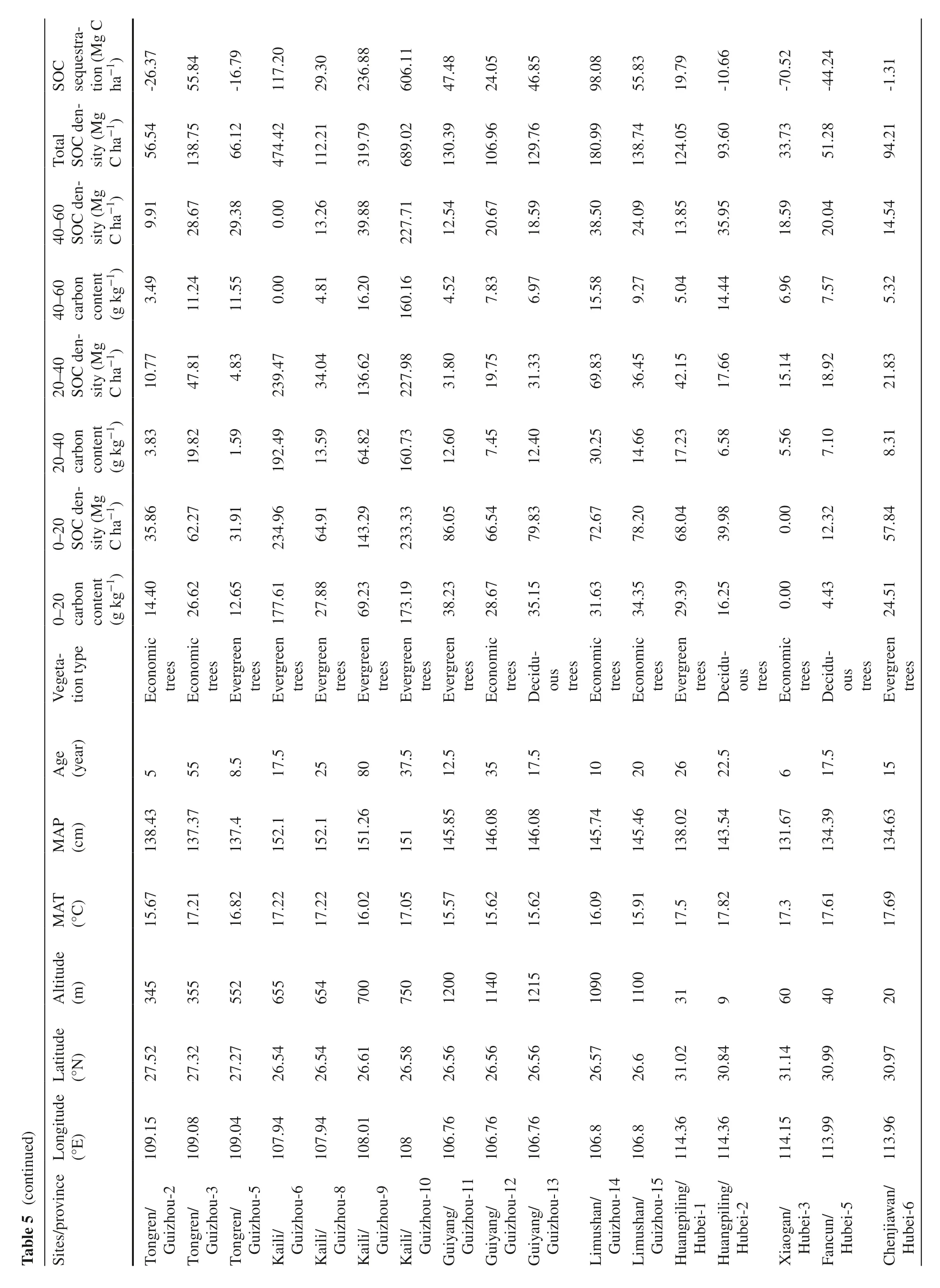
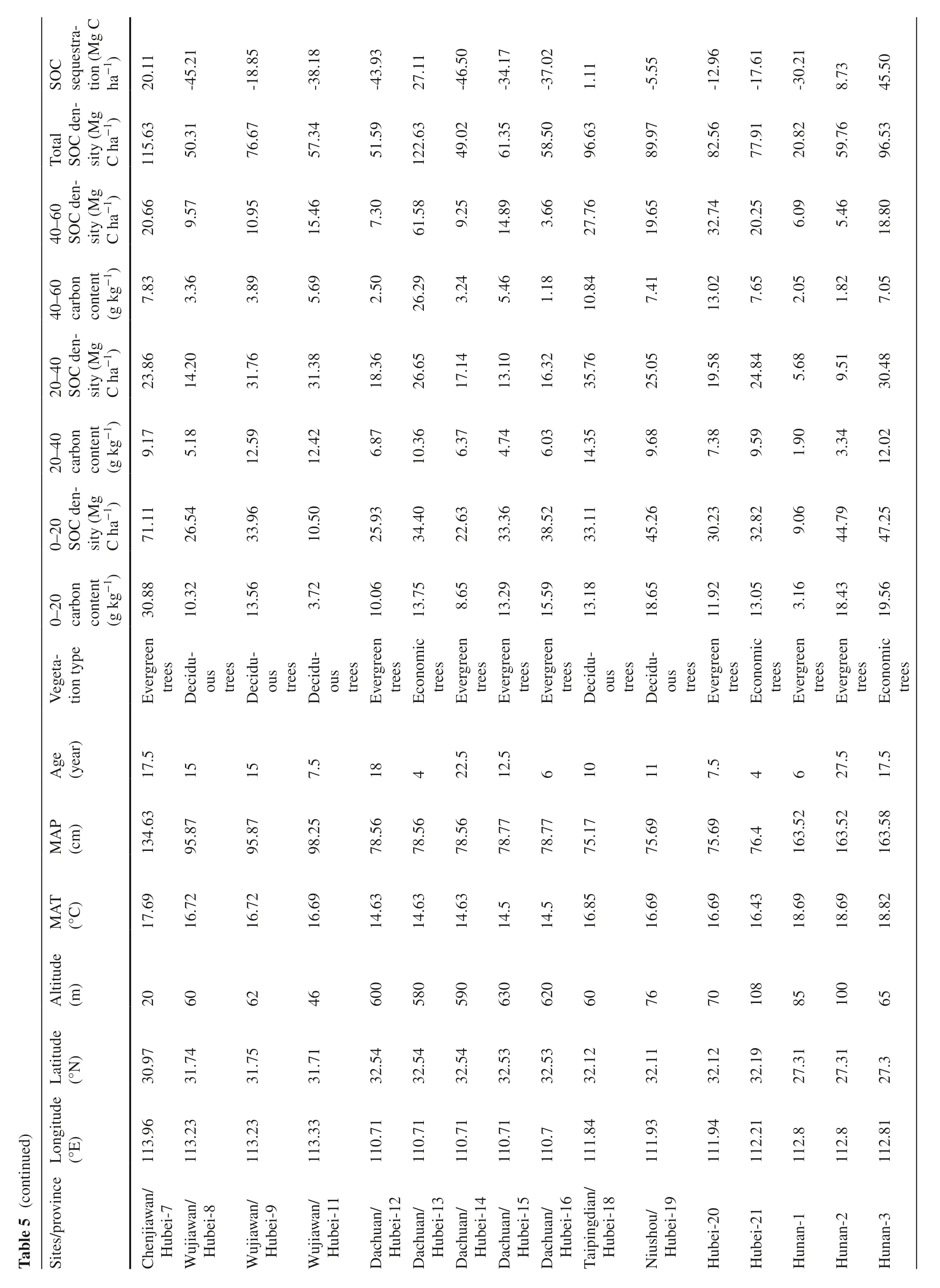
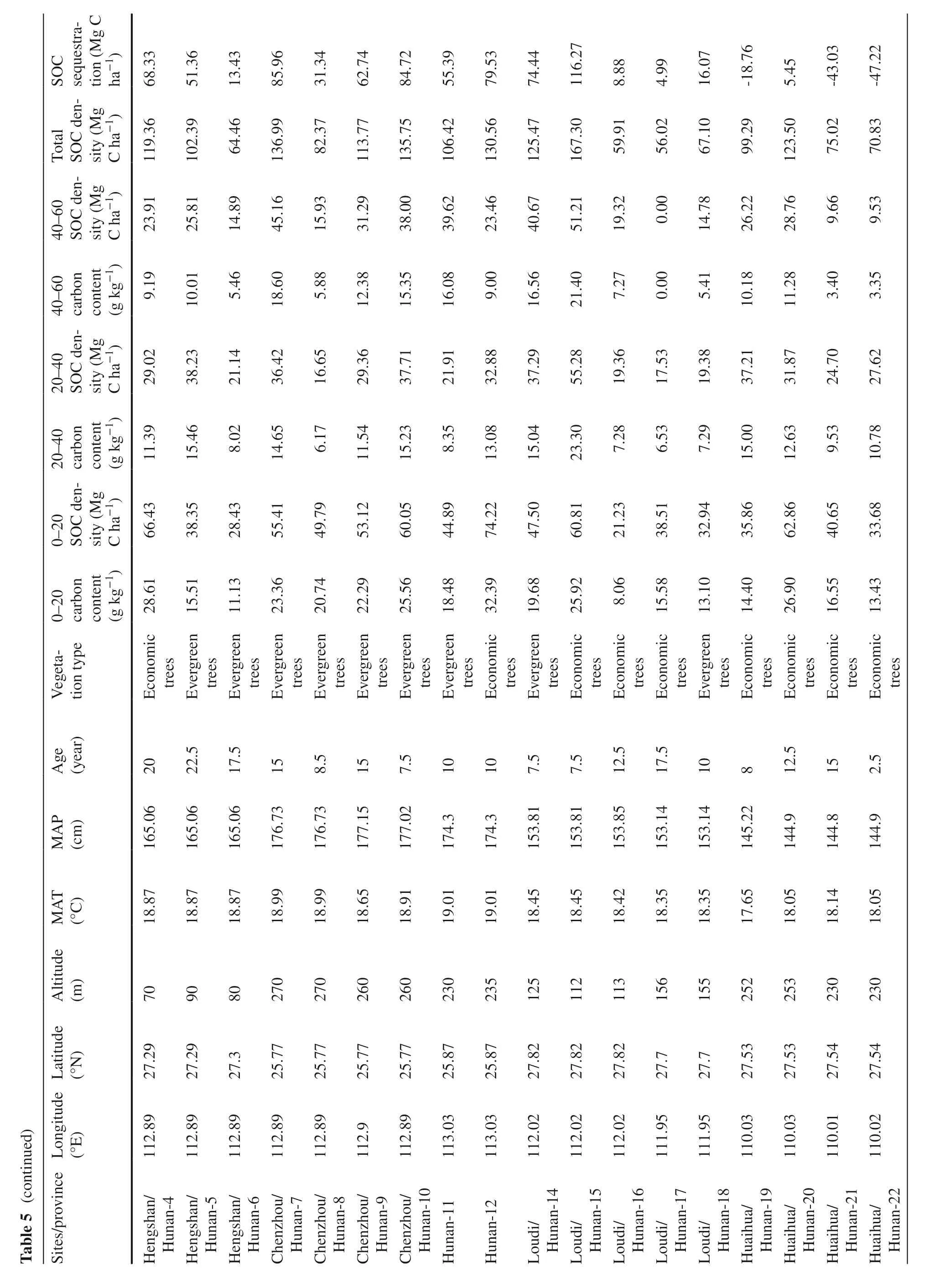
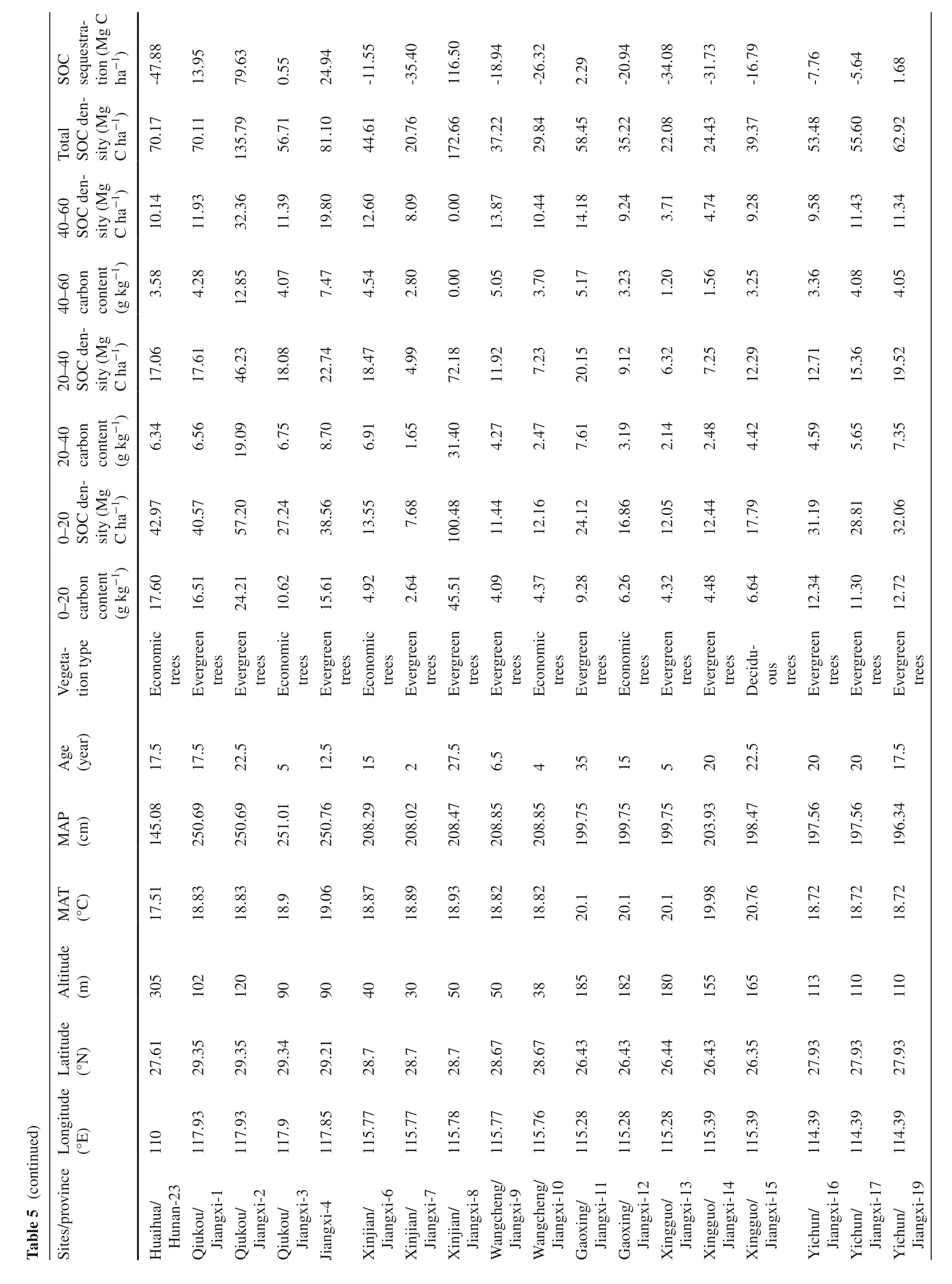
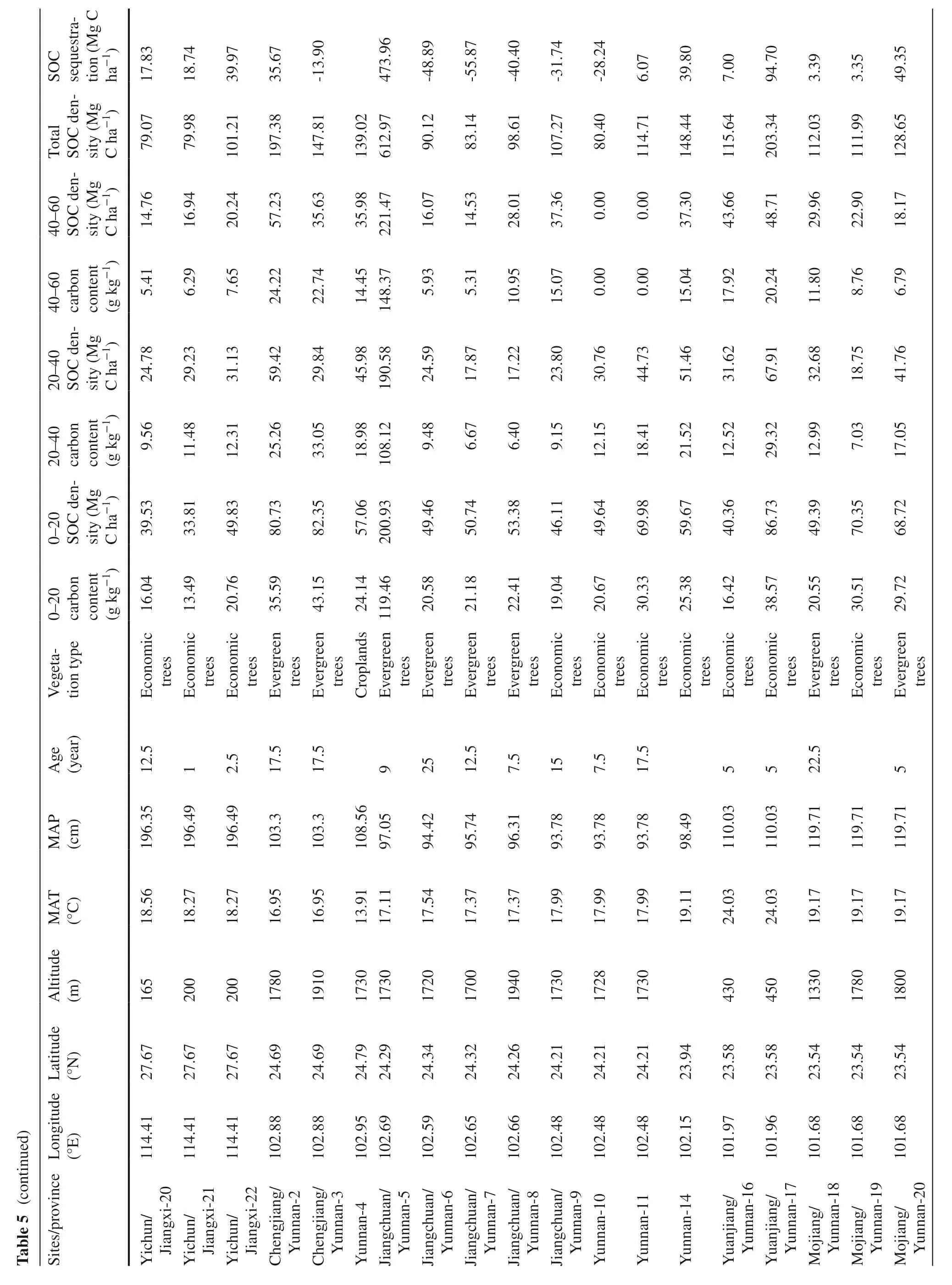
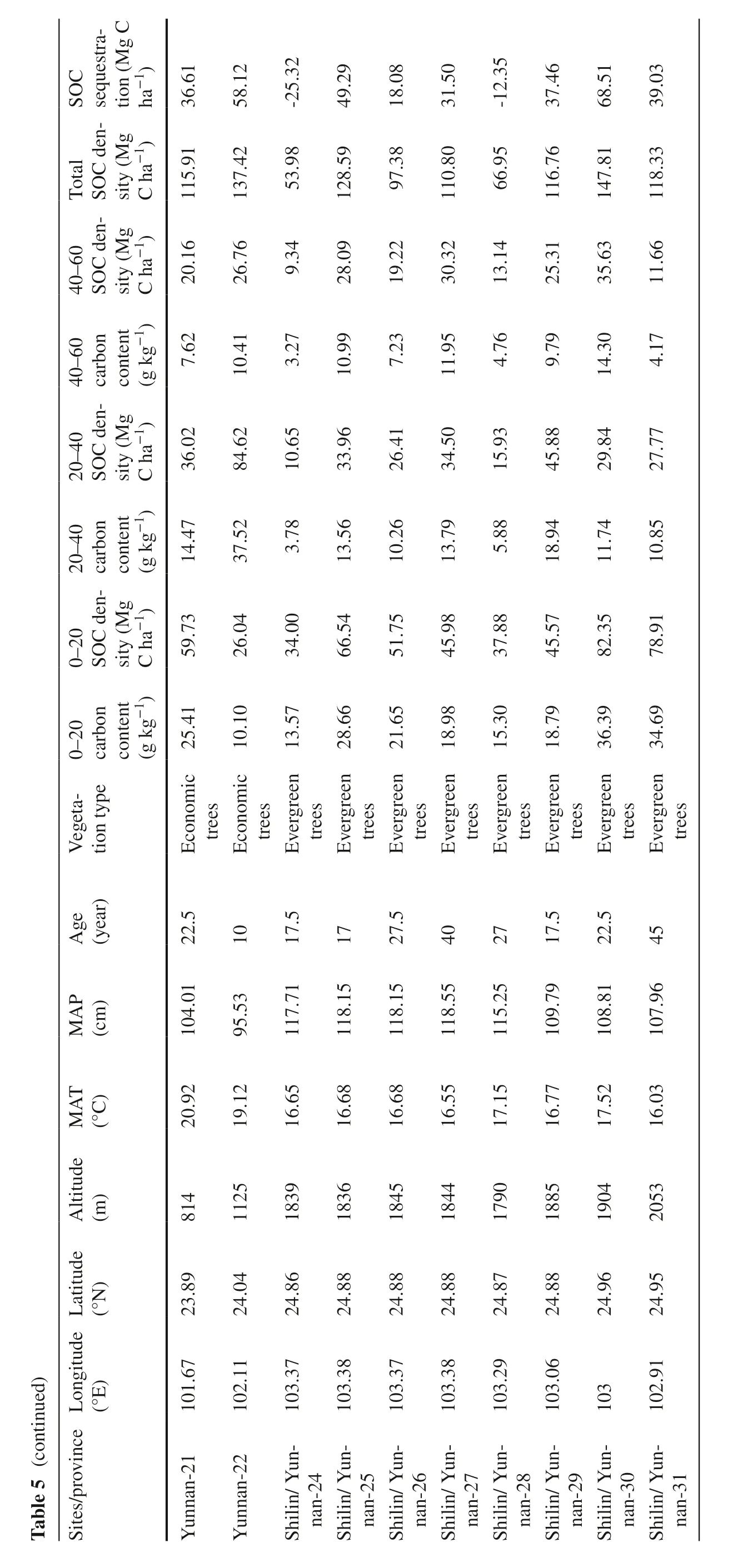
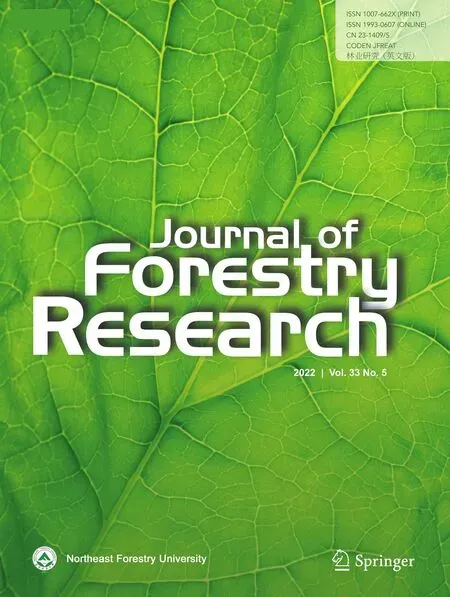 Journal of Forestry Research2022年5期
Journal of Forestry Research2022年5期
- Journal of Forestry Research的其它文章
- Correction to:Morphological and phylogenetical analysis reveals that a new tapeworm species (Cestoda:Hymenolepididae)from whooper swan belongs to Cloacotaenia not Hymenolepis
- Correction to:Within-and between-population variations in seed and seedling traits of Juglans mandshurica
- Correction to:Effects of chemical sterilization of the culture media,porous membranes and luminosity on in vitro culture of Eucalyptus grandis ×Eucalyptus urophylla
- Effectiveness of entomopathogenic fungal strains against poplar/willow weevil (Cryptorhynchus lapathi L.) larvae
- Monitoring spatiotemporal soil moisture changes in the subsurface of forest sites using electrical resistivity tomography (ERT)
- Variations in growth traits and wood physicochemical properties among Pinus koraiensis families in Northeast China
